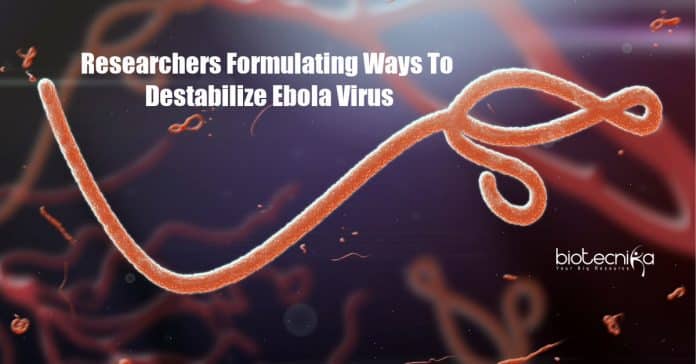New Ebola therapeutic study targeting the nucleocapsid of the virus.
While the world grapples with the SARS-CoV-2 pandemic, another virus is causing rage in the Democratic Republic of Congo recently: Ebola. The first outbreak of Ebola was seen in 2013, and since then has been emerging in Africa from time to time, causing terror with excessive bleeding in its victims, leading to death in many cases.
These infectious viruses hijack the host cells and re-program them into replicating machines for the virus.
Professor Juan Perilla, the University of Delaware, and his team consisting of graduate and undergraduate students are analyzing the inner working of Ebola with the help of supercomputers. The team is observing the movement of the molecules, atom by atom, and the functions are carried out in the organism. The structural feature of the Ebola virus’s coiled protein shell or nucleocapsid is studied. These structures may be potential therapeutic targets, as they can be destabilized easily, and an antiviral treatment can knock them out.
The study is published in the journal Chemical Physics on 20th October, Tuesday.
Perilla commented that the structure of the Ebola nucleocapsid is similar to that of a slinky walking spring with connected neighboring rings
. The team tried to pick the stability controlling factors of these springs in the computer simulations.The coiled nucleocapsids highly affect the Ebola life cycle. The single-stranded ribonucleic acid (ssRNA), which is the genetic material of the virus, is surrounded by this nucleocapsid. This RNA is protected by the nucleoproteins and is not recognized by the defense mechanism of the cell. The nucleoproteins interact with the different viral proteins like VP24 and VP30 and form a minimal functional unit– which acts as a copy machine– for the transcription and replication of the virus.
Perilla remarked that the most surprising finding for the team was that although for the stability of the nucleocapsid, nucleoproteins are important but in the absence of the ssRNA, the nucleocapsid becomes disordered quickly. But the stability of the nucleocapsid is not assured alone by the RNA. Nucleocapsid bound charged ion was also observed by the team, which may reveal the binding site for other cellular factors that stabilize the structure during the life cycle of the virus.
Perilla compared the work of the team to a search for nucleocapsid’s stability controlling molecular “knobs” like the volume controlling knobs that can be turned up to hinder the replication of the virus.
Two molecular dynamics systems of the nucleocapsid of the Ebola virus was built by the team to carry out the study. One of the system contained single-stranded RNA and the other included only the nucleoprotein. These systems then were simulated with the help of Fontera supercomputers from the Texas Advanced Computing Center– which is the world’s largest academic supercomputer. It took about two months for the completion of the simulation.
Chaoyi Xu, graduate research assistant, was responsible for running the simulation, while the analytical framework was developed by the entire team along with conducting the analysis. Xu and Tanya Nesterova, undergraduate research assistant wrote the manuscript, says that it has been a learning experience. With the support of UD’s Undergraduate Research Scholar and NSF’s XSEDE-EMPOWER she received training as a next-generation computational scientist. With the help of this training, she was allowed to use the nation’s top supercomputers and perform the highest level of research. Perilla also added that the contribution of Nidhi Katyal, who is a postdoctoral researcher, and her expertise was essential to complete the project.
The discovered vaccine is needed to be kept at extremely cold temperatures and this is a hindrance for its operation in remote regions of Africa, the site of the Ebola outbreak. The question of the moment is if the work by the team will help advance new treatments?
Perilla said that the team being basic scientists are excited to understand the fundamental principles of Ebola. The most abundant protein in the virus is the nucleocapsid and is also highly immunogenic, i.e, produce an immune response. New antiviral treatments may be facilitated with the finding of the team added Perilla.
Perilla and Jodi Hadden-Perilla are currently working on COVID-19 causing viruses with the help of supercomputer simulations. Although Ebola and COVID-19 nucleocapsid share some similarities in their structure– like similarity in the rod-like helical protofilament shape and both being involved in the transcription, replication, and packing of the viral genome– that is the end of the similarities between both the virus.
Perilla said that the team is currently refining the methodology used for Ebola to apply it to SARS-CoV-2.
New Ebola therapeutic study targeting the nucleocapsid of the virus.






























